Working with demotions¶
Demotions is a method to temporarily decrease the strategy score of selected products and variants in a market. It is useful for use cases such as demotions of a suppliers products, demoting seasonal wear or demoting certain brands or type of products. A demotion will bury products in search results, category pages, and other locations where demotions are supported. All demotions are managed in the Business app.
Disclaimer
App design and features are subject to change without notice. Screenshots, including simulated data visible, are for illustrative purposes only.
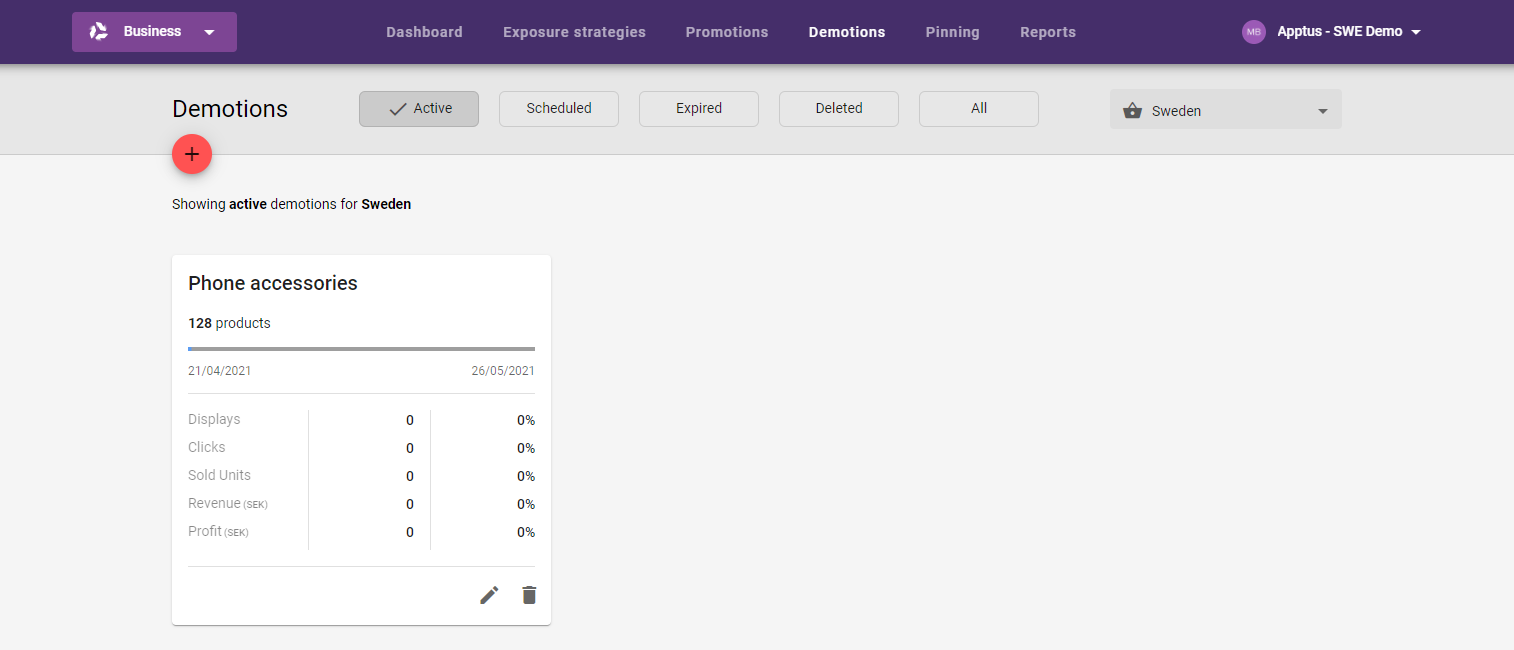
Before a demotion can be created, the Admin app must be fully configured. Access for users to the Demotions tab is set in the Admin app User management tab on a per user basis.
Demotion basics¶
Each demotion is identified by a name and has start and end date, and is active in one or more markets. The maximum length of a demotion name is 50 characters. During the demotion, the strategy score of each product is adjusted to be lower than all products which are not part of a demotion, thus being buried in results. Statistics are collected during the demotion and can be measured. All variants of a product will get individual rankings based on the variant performance and demotion. A demotion can be restricted to only be active in selected categories.
Demoting promoted products
If a product or variant is part of both a demotion and a promotion at the same time, the strategy score from the demotion has the highest priority and will be used.
It is not recommend to have too many active demotions or promotions at the same time. Too many demotions or promotions will likely result in unintended outcomes and require a lot of manual labour.
Maximum number of demotions and promotions
There is a limit of a total of 100 simultaneously active demotions and promotions in a market. If the limit is reached, other currently active demotions or promotions can be either rescheduled or removed to allow for the creation of a new demotion.
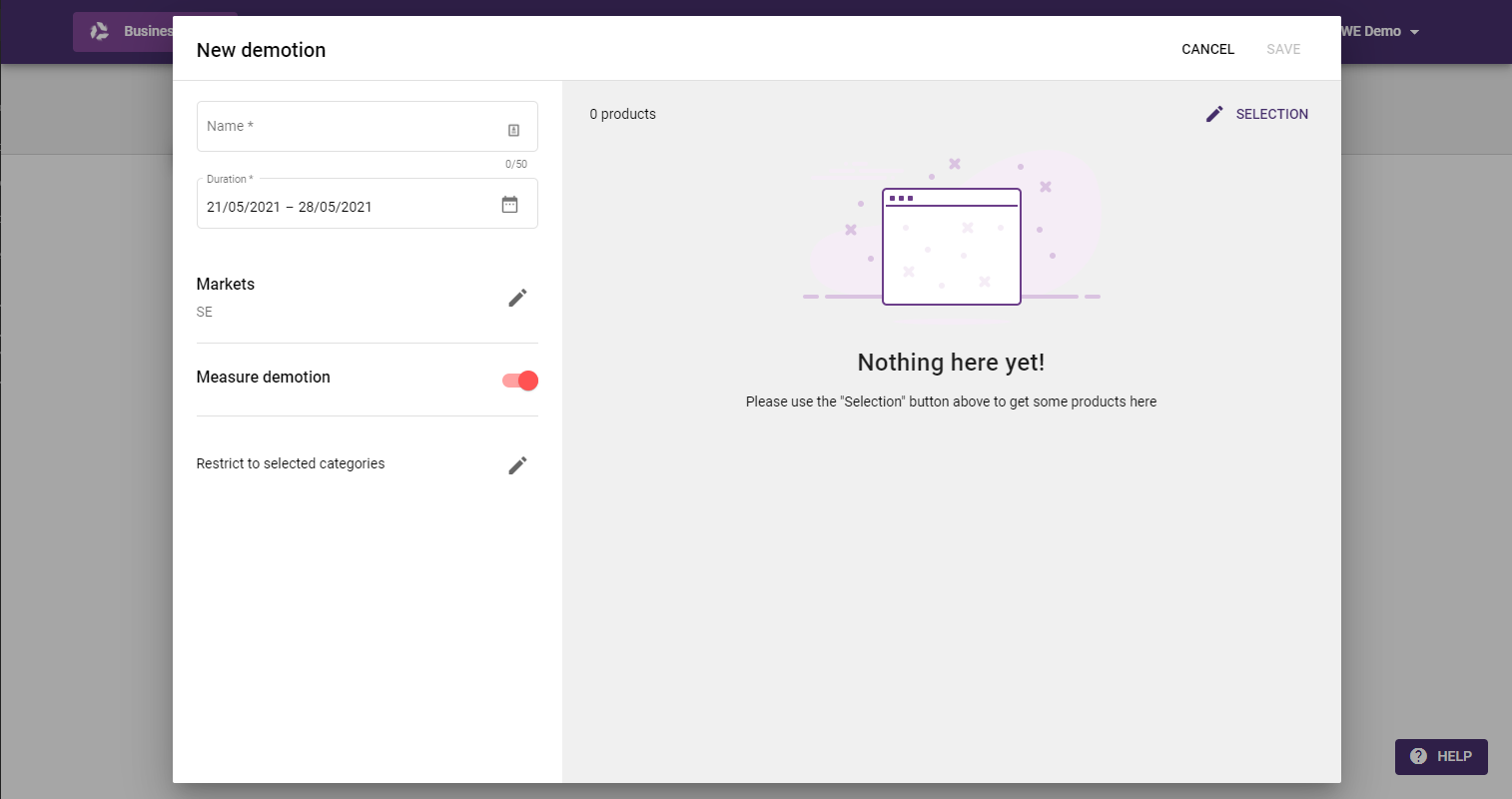
Markets¶
A demotion can be active in one or more markets at the same time. The selected products and variants of the demotion are based on the products and variants present in the current market in the apps.
Statistics¶
During a demotion period, aggregated statistics for all buried products/variants are collected for displays, clicks, sold units, revenue, and profit. Revenue and profit are shown in the currency configured for the current market.
Statistics can be measured to show the impact of the demotion. When activating measurements, 80% of the sessions will show the demotion and 20% will not. The impact is measured by comparing the statistics from sessions with demotions to sessions without demotions. The aggregated statistics of a demotion are based on all sessions, i.e. both sessions with and without demotions.
Notification set-up and implementation affects the statistics collected. Incorrectly set notifications will result in incorrect statistics. It is not always recommended to measure demotions.
Selecting products and variants¶
Products used in a demotion can be either handpicked or included (or excluded) by rules. Variants can only be included (or excluded) by rules.
Handpicked¶
Products can be handpicked for a demotion. The Search box can be used to search for products using the search attributes configured for the products, including product_key. Up to 700 products can also imported via the menu in the top right hand corner of the dialogue window. Hand picked products can be removed from a demotion directly from the main Edit demotion dialogue window. A demotion of a hand picked product demotes all the variants of the product.
Products can be easily handpicked on all markets in a demotion, by selecting the multimarket option. To be able to perform multimarket handpicking, the cross market product key attribute and market must been configured in the Admin app. This is particularly useful when there are multiple products in the product data that refer to the same physical product on several markets. A product that is handpicked on all markets is indicated in the interface by a globe icon in the top left-hand corner of the product image.
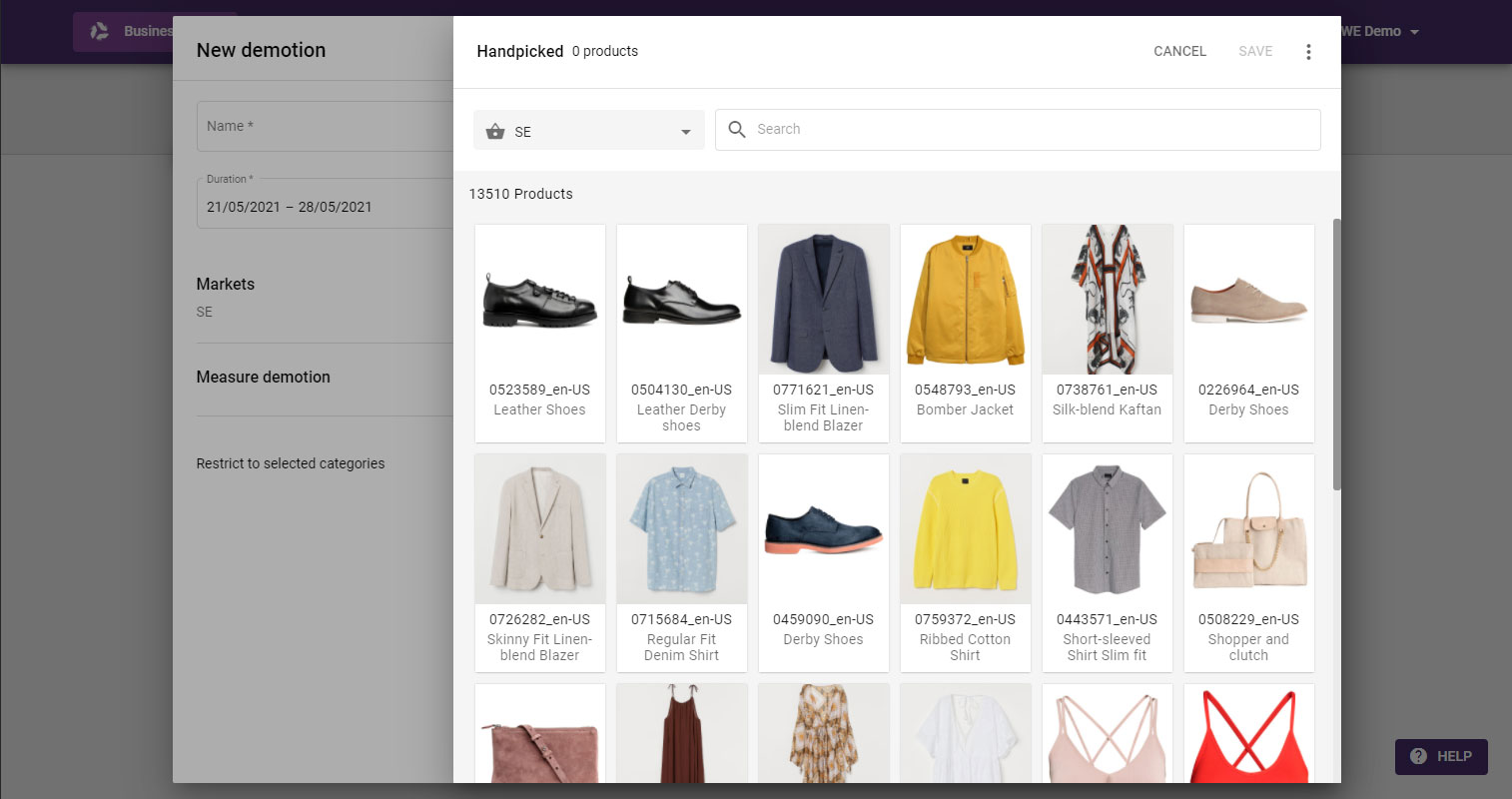
Rule based¶
Products and variants can be included in, and excluded from, a demotion using one or more rule sets. A rule set can include several rules where each rule can either include or exclude products/variants where a configured attribute, such as a brand name or a product category, has one or more values found in Elevate.
Products will be demoted if only product attributes are used. If at least one variant attribute is used in the rule, the demotion will be set to the variants matching the rule. If an attribute is a product attribute or a variant attribute depends on the data model setup and how attributes are used in the product import. If a product does not have variants the product itself is seen as a variant.
If more than one value is selected for an attribute in a rule, the values are to be considered as using the logical OR operator. I.e. if a rule with the attribute brand has both Adidas and Nike as values, products with brand configured as Adidas or Nike will be selected.
Each additional rule in a rule set is based on the data returned by the previous rule (logical AND operator). The final product and variant selection within the rule set is based on the data returned by the last rule. This is useful when narrowing down a product set. For example, a rule set has two include rules where first rule has the attribute brand and the value Adidas, and the second rule has the attribute color and the value Black. The final product selection within the rule set are products with the color set to Black from the data set where the brand is Adidas.
It is not recommended to use different rules using include with the same attribute within a rule set as they most likely return no products. I.e. if a rule set has two include rules where first rule has the attribute brand and the value Adidas, and the second rule also has the attribute brand but the value Nike, it will not return any products or variants at all. This is because no products and variants with Nike as brand are present in the data returned where brand is Adidas.
Several rule sets can be used simultaneously. The rule sets operate independently of each other (logical OR operator).
Individual products included by a rule set can be excluded if they are are deemed unfit for the demotion. The products can either be excluded using a rule to exclude products and variants by their id's or by selecting them individually in the demotion details view. Selected products are dimmed with a text denoting that they are blocked.
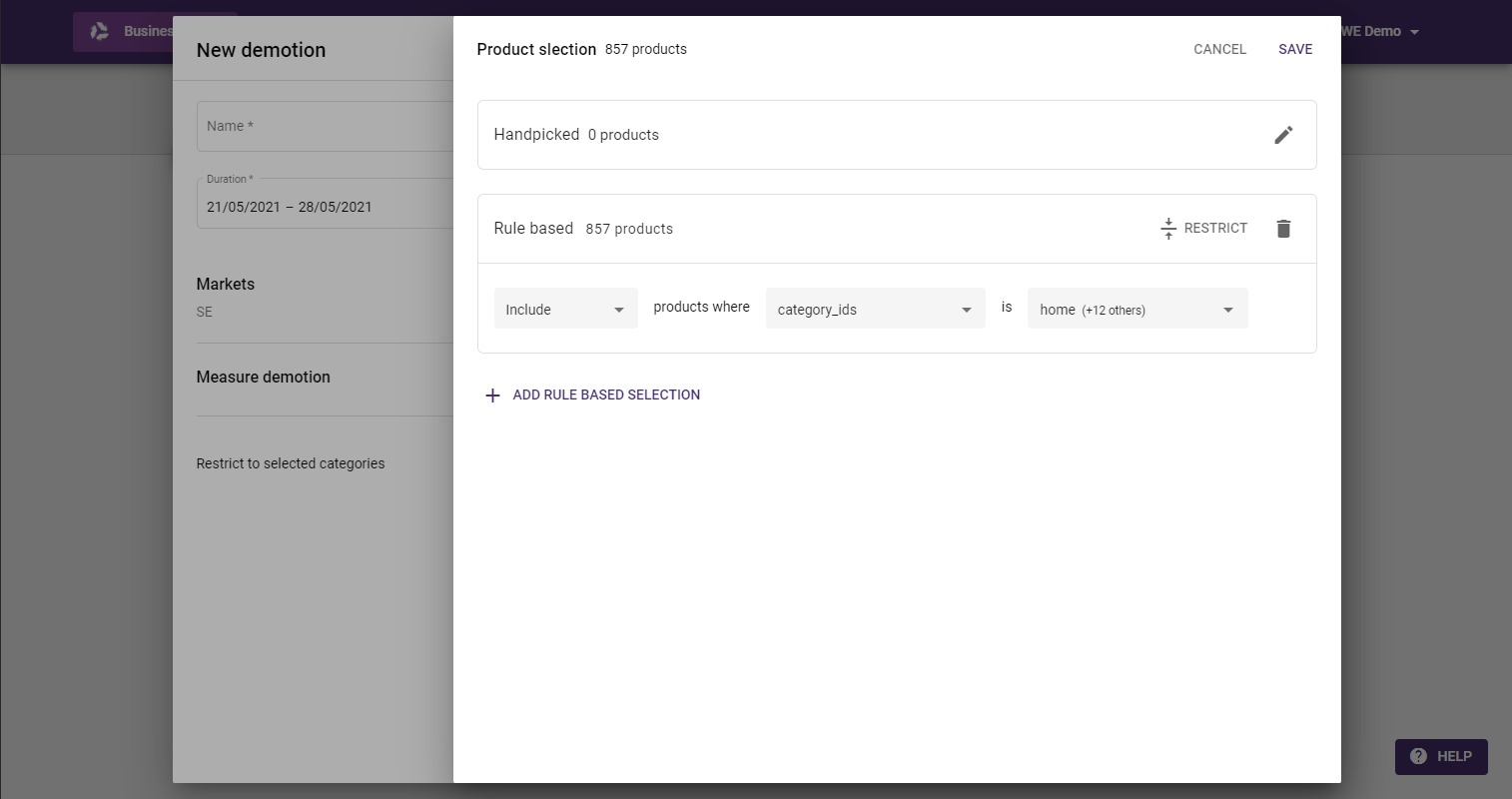
Restricting demotions to categories¶
A demotion can be restricted to only be active in selected categories. The available categories are defined by the product selection in the demotion. The Related categories option only show categories with products affected by the demotion while All categories also show the categories where there are no products affected.
Selecting a category will automatically include all sub-categories of the selected category. Sub-categories can also be individually selected and deselected in the interface.
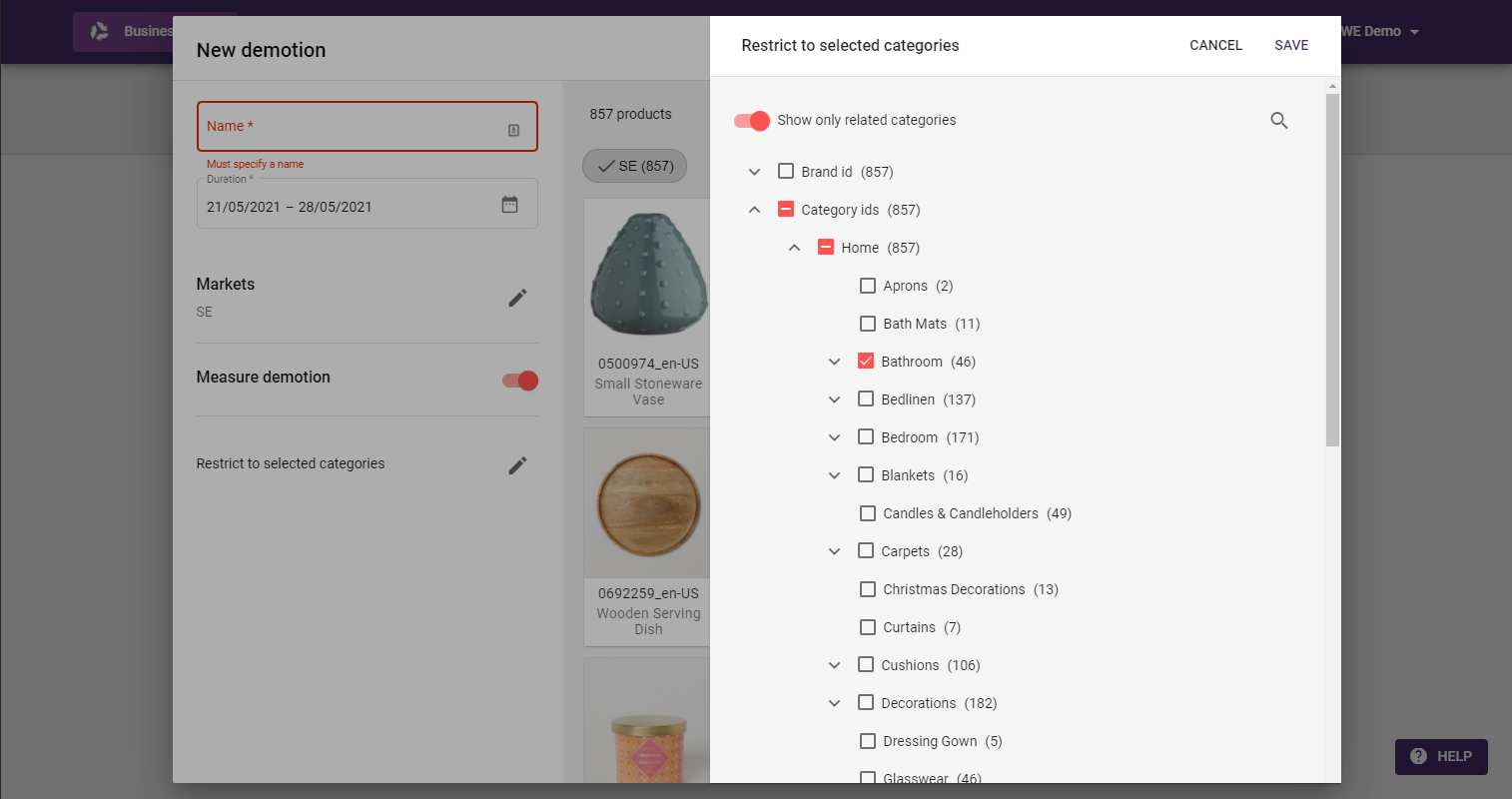
Use cases¶
Key use cases includes demotions of a specific suppliers products, demotions of a product type (like spare parts), and demotions of seasonal products.
Best practice¶
- Do no use multiple
includerules with the same attribute and different values within a rule set, instead use oneincluderule with one attribute and multiple values. - Measure statistics of a demotion if needed.
- Use rules for inclusion before rules for exclusion in a rule set.
- Define the product selection before restricting a demotion to categories.
Panels supporting demotions¶
Depending on what panel is used, demotions are utilized either fully or partially. Panels that partially utilize demotions, such as the Autocomplete panel, use product demotions on product backfill. Multi-level sorting will affect demotions.
When restricting a demotion to a category, the panel argument selected_category must be used.
Demotions are fully utilized in:
- Product list panel, when using relevance or sales as sort order
- Product list with count zone, when using relevance or sales as sort order
- Search hits panel, when using relevance or sales as sort order
- Search hits with count zone, when using relevance or sales as sort order
- Search zone when using relevance or sales as sort order
Demotions are partially utilized in:
- Product list panel, when using personal as sort order
- Product list with count zone, when using personal as sort order
- Autocomplete panel
- Did-you-mean panel
- Product suggestions panel